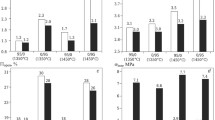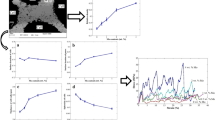Conclusions
During treatment of PNS type porous permeable specimens with hard particles at a velocity of 12 m/sec, the metal particles experience only slight surface microdeformation. Under these conditions the pore size decreases by a factor of only 1.25 or less. The substantial fall in permeability observed in this case is due to blockage of specimen pores by the hard particles and to closure of some pores during the plastic flow of metal on the specimen surface. Treatment of PNS type porous permeable specimens with hard particles at a velocity of 40–60 m/sec is accompanied by appreciable plastic deformation of metal particles on the specimen surface. The pore size decreases to one-fifth or less with PNS8 and PNS10 and to less than 1.19 μm with PNS5 and PNS6. The permeability of specimens falls, but their coefficients kpe are higher than the values calculated for these PNS types. Treatment of S200 and S450 gauzes with hard particles at a velocity of 24–80 m/sec induces plastic deformation of their weft wires, with only a slight decrease in their mean pore sizes. At a particle velocity of 80 m/sec S450 gauze disintegrates.
Similar content being viewed by others
Literature cited
A. A. Gatushkin and S. M. Solonin, “Filtering properties of twin-layered sintered filters,” Poroshk. Metall., No. 7, 32–37 (1966).
G. F. Tikhonov and V. K. Sorokin, “Sintered metallic filter materials for fine purification,” Energomashinostroenie, No. 12, 26–27 (1976).
A. F. Silaev, O. P. Danilova, and S. P. Gromova, “Materials with capillary structures for liquid and gas filtration,” Poroshk. Metall., No. 9, 45–49 (1978).
S. V. Belov, P. A. Kulu, P. K. Kallas, and G. P. Pavlikhin, “Effect of surface erosion on the hydraulic resistance of porous metals,” Poroshk. Metall., No. 9, 19–22 (1980).
P. A. Kulu, O. D. Bussel' and V. S. Pugin, “Erosion resistance of porous permeable iron,” Poroshk. Metall., No. 7, 58–62 (1974).
I. R. Kleis, “TsUK-3M centrifugal accelerator for determining the relative wear resistance of materials during abrasive erosion,” Tr. Tallinsk. Politekh. Inst., Tallin, Ser. A. No. 294, 23–33 (1970).
Author information
Authors and Affiliations
Additional information
Translated from Poroshkovaya Metallurgiya, No. 5(245), pp. 41–47, May, 1983.
Rights and permissions
About this article
Cite this article
Belov, S.V., Ksenofontov, A.V., Kulu, P.A. et al. Effect of surface erosion of porous metals on their structural and hydraulic characteristics. Powder Metall Met Ceram 22, 361–367 (1983). https://doi.org/10.1007/BF00796925
Received:
Issue Date:
DOI: https://doi.org/10.1007/BF00796925




